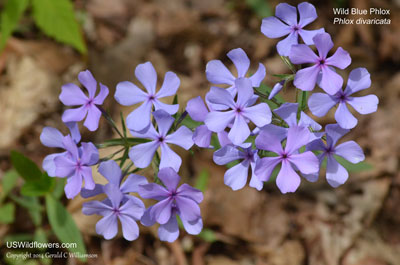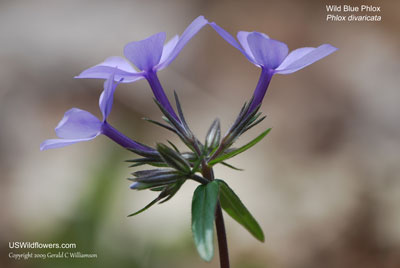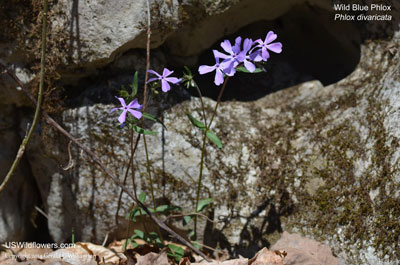Wild Blue Phlox, Woodland Phlox, Sweet William, Louisiana Phlox - Phlox divaricata
|
Phlox divaricata - Wild Blue Phlox, Woodland Phlox, Sweet William, Louisiana Phlox.
The Phlox family - Polemoniaceae is primarily a family of the Americas with about 350 or so species. There are about 70 species in the Phlox genus. Phlox species can be very difficult to differentiate. Not only do several species share similar shapes in both the flower and the leaves, but the color ranges are broad and similar. You have to look at details to differentiate between many of the plants in this genus.
Phlox divaricata is a plant of rich moist deciduous woods and bluffs of much of the eastern half of the United States and southeastern Canada. The reports that it is in New Mexico appear to be unsupported.
Found in:
AL, AR, CT, DC, DE, FL, GA, IA, IL, IN, KS, KY, LA, MD, MI, MN, MO, MS, NC, NE, NJ, NY, OH, OK, PA, SC, SD, TN, TX, VA, VT, WI, WV, GS
Leave comments on Phlox divaricata at this link. | 
Distribution of Phlox divaricata in the United States and Canada:

Map courtesy of The Biota of North America Program.
Map color key
Search Our Database: Enter any portion of the Scientific, Common Name, or both.
Do a general Google search of the entire site:
#ad
 Follow USWildflowers on Twitter
| | Site: The Pocket at Pigeon Mountain, Walker County, GA Date: 2009-March-18 | Photographer: Gerald C Williamson
Nikon D60
1/125f/5.6 ISO100 | | This specimen has an uncharacteristic 6 petals. Phlox blossoms normally have 5 petals. Among the key characteristics for identifying Phlox to the species is whether the stamens are exserted (extending beyond the corolla tube) or included (contained within the corolla tube.) The stamens of Phlox divaricata are included. See Phlox glaberrima for an example of a species with exserted stamens. | | 
| | Site: The Pocket at Pigeon Mountain, Walker County, GA Date: 2015-April-09 | Photographer: Gerald C Williamson
Nikon D7000 | | Phlox divaricata flowers usually tend toward blue, but may be pinkish or occasionally completely white. The (usually) 5 corolla lobes are about 1/2" long, and the tips may be notched (subspecies divaricata) or may not be notched (subspecies laphamii). | | Click on the photo for a larger image

| | Site: The Pocket at Pigeon Mountain, Walker County, GA Date: 2009-March-21 | Photographer: Gerald C Williamson | | The flowers of Phlox divaricata are "salverform" - they have a narrow corolla tube which abruptly flares to lobes which are held at nearly a 90-degree angle to the tube. The tube in Phlox divaricata is glabrous - some similar Phlox have hairy corolla tubes. The pedicels and calyces of Phlox divaricata are glandular-hairy. The calyx teeth are much longer than the calyx tube, and are very narrow and pointed, sometime with a short awl-like tip. | | Click on the photo for a larger image

| | Site: Walls of Jericho Trail, Jackson County, AL Date: 2014-April-01 | Photographer: Gerald C Williamson
Nikon D7000 | | I've seen the stems of Phlox divaricata described both as decumbent with erect branches, and as erect or decumbent. From my limited personal investigation, I tend toward the former - decumbent with erect shoots. In either case, the erect shoots are around 8 to 21 inches tall (usually at the shorter end than taller), and may branch only near the inflorescence, with inflorescences terminating the flowering stem. Phlox divaricata may have both flowering and non-flowering stems, with the flowering stems usually shorter than the non-flowering stems. The leaves are 1 to 2 inches long, opposite, entire, and acute (but not sharply pointed) on flowering stems, obtuse on non-flowering stems. | | Click on the photo for a larger image

|
References used for identification and information:
|
|
| |
| #ad
|
|






